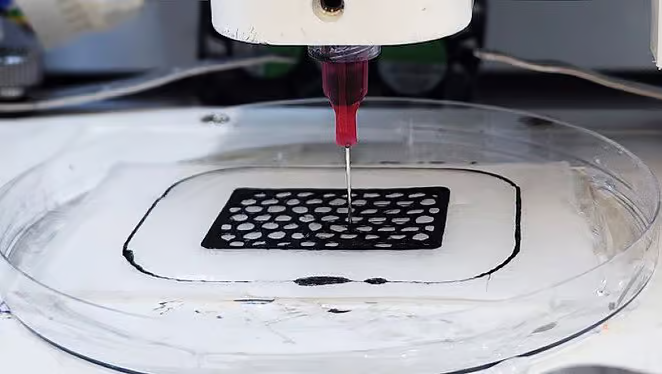Researchers demonstrate sustainable 3D printing by using poly(N-isopropylacrylamide) solutions (PNIPAM), which speedily and reliably turn solid by undergoing a rapid phase change when in a salt solution.
 This property has been used to 3D print objects by using a syringe tip as if it were a nozzle in a filament-based printer. As long as the liquid is being printed into contact with a salt solution, the result is a polymer that solidifies upon leaving the syringe.
This property has been used to 3D print objects by using a syringe tip as if it were a nozzle in a filament-based printer. As long as the liquid is being printed into contact with a salt solution, the result is a polymer that solidifies upon leaving the syringe.
What’s also interesting is that the process by which the PNIPAM-based solutions solidify is entirely reversible. Researchers demonstrate printing, breaking down, then re-printing, which is an awfully neat trick. Finally, by mixing different additives in with PNIPAM, one can obtain different properties in the final product. For example, researchers demonstrate making conductive prints by adding carbon nanotubes.
While we’ve seen the concept of printing with liquids by extruding them into a gel bath or similar approach, we haven’t seen a process that prides itself on being so reversible before. The research paper with all the details is available here, so check it out for all the details.
















Well it doesn’t look really solid in the water.. more like cooked spaghetti.
Notoriously liquid cooked spaghetti
https://www.sigmaaldrich.com/US/en/products/materials-science/biomedical-materials/hydrophilic-polymers?country=US&language=en&cmsRoute=products&cmsRoute=materials-science&cmsRoute=biomedical-materials&cmsRoute=hydrophilic-polymers&term=poly%28N-isopropylacrylamide%29&page=1
10g for $821…damn I hate being cheap….
Well, as resin prices are slowly dropping, mfgrs need a new way to gouge their customers!
B^)
(Sort of like Freon mfgrs find a new/better/greener/mandatory replacement for their products that have left patent protection.)
Yeah, yeah, and Sigma-Aldrich sells sodium chloride (table salt) at USD 48.10 for 500g. I’ll happily pick some up at the corner grocery and resell it to you for HALF that price.
Lesson: Sigma-Aldrich is not generally the most economic source for bulk consumables.
So. What are the toxicities of this material? Chemical? And if course, particulate as we work it post printing. Anyone ever look at how the chemiical agents any of the materials used interact with paints, glues, etc?
It’s in the linked paper
” PNIPAM is widely recognized as a non-cytotoxic, non-genotoxic, and biocompatible material”
I was wondering how it interacts with itself – I don’t see actual printing happening, which means it needs to bond to itself. Even if it does have cooked spaghetti texture, as long as it actually prints and bonds to itself well enough, it would still be super useful for scaffolds for other structures.
So it makes you wonder, could one use other, cheaper phase change materials and print into some substance that holds it at the right temperature to stay solid? That might make a really interesting support structure for delicate bio-printing.